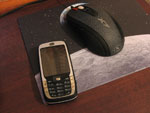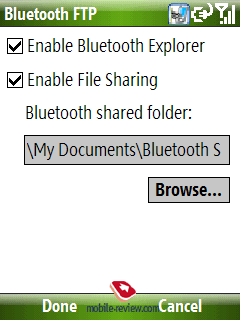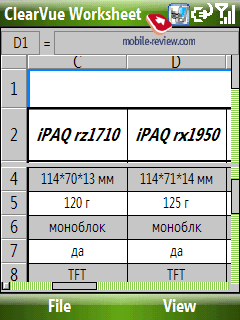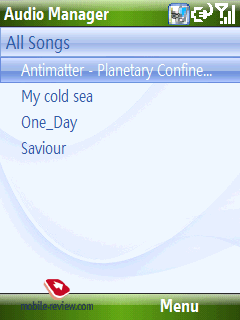|
|
Review of GSM-smartphone HTC S710 (Vox)
Live photo of HTC S710 (Vox)
Sales package:
- Smartphone
- 1050 mAh battery
- User Guide
- Charger
- CD with software (ActivSync and Outlook)
- Mini-USB data cable
- Stereo-headset
We are ought to note that the unit we got our hands on is not the final version of the smartphone. It is still far away from the release day and some aspects might undergo changes – both software- and hardware-related ones. So we have decided on the same thing we did with HTC Excalibur review. This very article is a preliminary review that is to be updated once the smartphone arrives in the market.
For HTC creating offbeat devices has already become its routine – not in the sense of ease of production, but rather in the sense that the company presents the users and Windows Mobile market with more of its new products. Here we should mention that after a few years on the market, with one of them spent under own brand (HTC), not only has the company secured the position of the leader, it continues delivering new ideas and concepts.
Smartphone HTC S710 (codenamed Vox) is another phase of WM platforms development. On top of that, this device may well give birth to a new range of smartphones and communicators housed in the new form-factor. In case of HTC S710, it is a conventional-looking candy-bar with a numberpad and a slide-out thumbboard. Software-wise, the Vox builds on HTC Tornado with much of the specification unchanged, as even two years after release its performance is suited to meet most needs of the users.


Design and controls
New HTC-branded models pleasantly surprise with wide selection of designs and styles, in this regard the Vox provokes some interest. Measuring up at 101.5x50x18.6 mm and weighing in at 140g it can be rightfully called portable, if thick. In fact not only does the smartphone look good against the background of other smartphones in terms of dimensions, it proves to be more pocketable than most of them. The device readily slips into just about any pocket, unless it is in your jacket’s pocket, where it will give a weighty feeling – at the end of the day the weight of 14 grams is something to reckon with. We have to admit, that looking at its vest-pocket size, you don’t expect HTC S710 to turn out such a heavyweight.


The model comes only in a single color scheme – black casing with a few flashes of grey and silver. The smartphone’s design doesn’t feature any sharp edges or ridges – overall it is very smooth and streamlined. Most of its parts enjoy soft-touch coating, first used in Motorola PEBL U6 – we have written about the benefits it brings countless times. Quality of the plastic, as well as the overall build quality is decent, but we will talk about that as we dig deeper into the review. The rear, as well as the sides and ends are finished in soft plastic too. On the fascia soft-touch surface is applied on the numberpad, with the display edged by a light-grey strip.

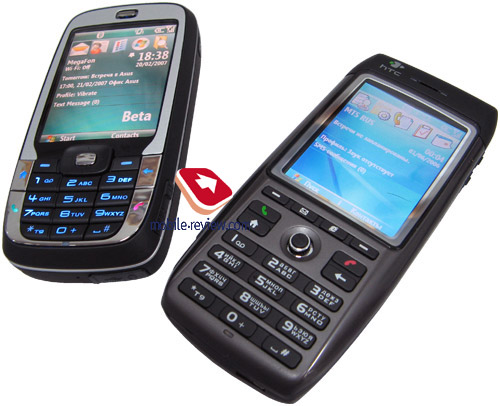
After grabbing the device, the first thing that catches your eyes is the big TFT display, occupying 2/3 of the face plate’s real estate. The screen is protected by a plastic layer, covering its active area and ending at the border with the numeric pad. Doing so allows making the display dust-proof. The screen is topped by an earpiece, flanked by charging and wireless status LEDs.
At the bottom of the right spine is a microSD memory expansion slot covered by a rubber flap, linked to the casing. Looking at the top of the right side reveals dedicated camera button, while on the opposite side you will find volume rocker key positioned more towards the upper end, and voice button a bit lower.
Another thing of note is that the side-mounted keys are flush with the spines’ surface, which occasionally gives you a hard time pressing them. For example, when managing volume level during a call – to adjust volume you will need either to locate it find by feeling (takes time) or take away from your ear, thus interrupting the conversation. Completing the exterior is the SIM-card socket on the left spine.



The socket employs an unusual design, as opening it is possible only after zipping the Vox open. The card’s bed is placed at the bottom of the half housing the display. To insert or extract a SIM-card you just need to take off the cover protecting the slot. This locker surprisingly proves to be handy, as you are now free of the hassle to open the back cover and detach the battery.


The top end would be completely bald, if only it didn’t house the multifunctional button for switching the device on/off, swapping profiles and activating connectivity menu. The bottom rim plays host to ExtUSB socket, sealed by the same rubber flap linked up with the casing. The company sticks to its traditions, meaning that this slot serves for plugging in charger, data cable and headset. The good news is that with every passing month the chances that ExtUSB-3.5mm adapters will make it to the Russian market are growing. And if it won’t be the original adapter, then it might be Brando’s unit, whose sales have already kicked off in Europe.

The left corner of the bottom end features holes for the carrying strap or arm-band. It is good to know that over at HTC they haven’t forgotten about this trinket.

The rear of the smartphone doesn’t have much to offer – its top part, specifically the silver-decked platform, holds a 2 Mpix camera lens and a self-portrait mirror. To the right of it is the loudspeaker, and to the left - rubber grommet covering an external antenna slot.

Build quality, slide mechanism
It wasn’t a fluke that HTC partnered up with HP, Dell, HP, Dell, Fujitsu Siemens and others to produce their devices back then. The build quality delivered by HTC has always been admirable.
Speaking of HTC S710, this is one of the foremost aspects due to the unconventional form-factor picked for the Vox. HTC’s solution has got indirect rivals in the form of Nokia E70, for example, but the latter sports different way of getting access to the thumbboard. So we may rightfully state that it is the world’s first smartphone showing off side-slider design. Undoubtedly, the build quality and the slide mechanism implementation are very crucial here.


The model boasts superb build quality – partly this impression is amplified by the soft-touch plastic, which delivers good tactile feelings. All details are precisely attuned to each other – no creaks or gaps at all. The smartphone is armed with auto completion mechanism – to open up the QWERTY-keyboard all you have to do is push the top part upwards with your right thumb, the phone will do the rest. Pay attention to the fact that the top half slides leftwards, so people who have gotten used to hold devices in left hand will find this mechanism less handy. But thanks to the proper size, sliding the Vox open with your left thumb is just as simple. In both cases you can just put your finger on the display and zip the smartphone open. Once opened the Vox will play a short signal or sound, that can be turned off. The display switches into landscape mode a few seconds after opening the thumbboard (2-4 seconds).
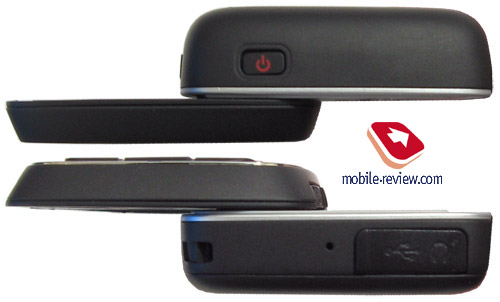
When closed, both halves are firmly attuned, there is almost no gap.
A few words about the smudge, fingerprints and dirt on the S710. By using soft-touch plastic the manufacturer has almost completely settled this question, but where this finishing is not applied, be sure that this area will pick up dirt with ease. Specifically, the side row of keys is fingerprints-prone, due to them being made of glossy chrome-esque plastic. You will have fewer problems with the display area, even though, dirt just keeps low profile over there – thanks to the plenty of screen real estate, dirt from ear and fingerprints aren’t visible with all these glares and tinges on the display.
Navigation controls, QWERTY-keyboard
When closed, the Vox is nothing more by a conventional-looking monoblock with a numberpad. The numeric keys are arranged in four rows, at that they get sized down as you go from the top to the bottom. These buttons are made of the soft plastic, similar to that used on the most part on the casing. The numberpad is topped by a 5-way navigational pad and two soft-keys. Pick/hang up buttons, as well as main menu shortcut and “Back” keys are mounted outside the numberpad. Owing to the silver finishing they get to look like chromed buttons, but in return pick up fingerprints and smudge in no time. As a matter of fact the side keys are the most dirt-prone details of the smartphone.


The central navigational pad is quite tiny, but managing it was never an issue. The edges of the button are slightly raised above the surface, which makes it even more comfortable to work with. On the whole, the navigation controls are pretty handy, but bear in mind that the buttons themselves are small-sized. People with big fingers might need some getting used to, but there is a good way-out – use the QWERTY-keyboard.
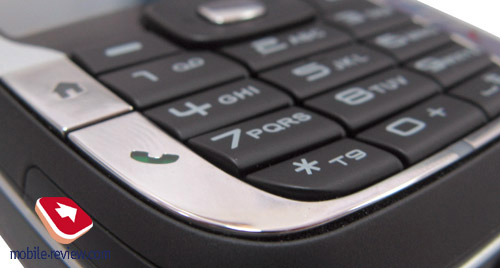

We mentioned above why HTC S710 smartphone may be considered as a new phase in the development of such product. Presence of a thumbboard and an offbeat form-factor contribute a lot to this. Sliding the smartphone open reveals a full-size thumbboard with the layout somewhat different to those of previous HTC-branded QWERTY-equipped devices, that is why we are giving it a close-up.
If you remember most of the modern Windows Mobile-based communicators sporting full-size thumbboard, then will certainly spot that the Cyrillic letters are laid out in a slightly different way than those on a PC keyboard. This, however, doesn’t make all the difference, since you have to go through getting-used-to process anyhow and eventually you will feel at ease while managing such thumbboard. In the previous HTC’s models QWERTY-keyboard was built in the following way: three rows, 10 keys in each, and the bottom row with service buttons. 39 keys in sum. Some of the Cyrillic letters were laid out in a way that one could use them only after pressing Fn button.
HTC S710 makes use of a new layout, boasting three rows with 12 keys in each, which gives us 36 buttons. But now, in theory, there is a possibility to put all Cyrillic letters on the placed we have used to see them on a PC keyboard. And if over at HTC they actually will go for this scheme, things won’t get worse at least, as all Cyrillic letters will be one press away, and the hassle of “Fn + button” combination won’t stand in your way anymore. On the other hand, there is an impediment, which lies in fewer buttons, compared to communicators, even though the difference is not critical. Once the device arrives in the market we will definitely check out the layout of Cyrillic symbols.


For menu management purposes there are two soft-keys located right beneath the display. Move your sight to the left to see Cap and Fn status indicators. Due to the casing being relatively small, all keys can’t boast bulky size, at that they are well-spaced, which allows avoiding wrong presses. There is no long travel, though, which is compensated with a short click. So at the end of the day the size of the keys almost doesn’t affect the thumbboard’s ease-of-use. The backlighting for the keyboard is very bright, so in the dark eyes get tired of the blue of the keys pretty fast. On top of that symbols blend with each other due to the excessive brightness of the light coming from beneath, and this omission will get only worse when additional keys caption will be etched on the keys. The numberpad is lit in the same bright-blue, which is not that blazing, though, because of the keypad’s lesser real estate.
Display
The device utilizes a TFT display with QVGA (320x240 pixels) resolution, capable of 65 K colors (the cap of WM6 OS). Physically, the screen has improved upon the previous generation of displays used by HTC. This has also impacted in a positive way the system and interface perception – they are much easier to handle now. Let’s compare diagonals and sizes of various displays:
HTC Hurricane/Tornado – 44.5x33 mm, diagonal of 2.2”
HTC S710 (Vox) – 49x36.5 mm, diagonal of 2.4”
Nokia E70 – 41x34 mm, diagonal of 2.1”
Nokia N73 – 50x37 mm, diagonal of 2.4”
As you see, the screen real estate is comparable with that of Nokia N73. The display quality has also been enhanced – now it shows bright and vivid picture that does get washed out in the sun yet information remains readable. Viewing angles were never a problem with the Vox – the image doesn’t get distorted at any angle be it vertically or horizontally. On release HTC S710 will carry the market’s best display among smartphones running on Windows Mobile, including Samsung i600 and HTC S630 (renamed HTC Cavalier). Over and above, in terms of picture quality and colors, it is in line with screens used by Nokia and Sony Ericsson and ends up slightly behind them brightness-wise.
Battery life
The smartphone comes included with a 1050 mAh Li-Ion battery. In conditions of Moscow networks at 30-40 minutes of calls a day, 15 SMS and 1 hour of e-mail management and Web surfing, the battery kept the S710 up and running for 2,5-3 days, which is a good figure for a QVGA-armed smartphone. When we get our hands on a commercial unit, we will put the battery through its paces in various modes.
Turning the smartphone around reveals the battery cover, which is quite thin, yet the risk of cracking it is minimal, as it is very flexible. The cover lock is simple – four slots located sideways and two on the ends. To remove it you will only need to pull it off the casing. Gap is non-existent here, and we failed to find a hint of it being unreliable. Also bear in mind the fact that to swap SIM-cards you won’t have to take off the battery cover and detach the battery.

Camera
HTC S710 makes use of the interface that has already been spotted on HTC’s latest offerings. It is a semitransparent menu laid on the viewfinder mode of the display. Generally speaking, it is quite comfortable but switching between menu items could be simpler. And now a few words about camera interface and settings
Current shooting resolution can be changed in Settings or by pressing key “2”. The following resolutions are available:
- 2M – 1600x1200 pixels
- 1M – 1280x960 pixels
- L – 640x480 pixels
- M – 320x240 pixels
- S – 160x120 pixels
Picture quality (affects mainly size of an image):
- Super Fine
- Fine
- Normal
- Basic
White balance (can be changed by pressing “3”):
- Auto
- Daylight
- Night
- Incandescent
- Fluorescent
Effects:
- Grayscale
- Sepia
- Cool
- Negative
Values of Contrast, Saturation, Hue, Sharpness, Contrast can be altered as well (adjusted automatically by default). Advanced settings include self-timer, time stamp, shutter sound and some more.
Sing “1” key you can easily navigate through the shooting modes and get into video capturing, for example. The device records video in MPEG4, MotionJPEG, H.263 formats with a resolution of M (176x144) or S (128x96). All in all the settings for video copy those of still images, the differences include: sound recording (on/off), adjustable clip’s length and size limits. Quality, as well as resolution, of the video clips captured with the S710 is quite mediocre.
Apart from photo and video modes the S710’s camera has some more to offer – video for MMS, still image for a contact, sport and framed modes, which can be activated by pressing “1”. As regards “sport mode” – it’s a sequence of shots (up to 5) taken in rapid succession. In framed mode you are allowed to lay one of the four frames over the snap. Pressing “#” in the viewfinder mode brings up all hot keys used for managing the camera, located in accordance with their functions next to the corresponding interface icon. “0” removes all interface elements from the viewfinder screen.
The quality of snaps is on the average level, yet turns out to be slightly higher than that put up by the company’s previous models. Nevertheless it is nowhere near Nokia or Sony Ericsson in this sense. You can check out the quality for yourself, looking at the sample shots.
 |
 |
(+)
maximize, 1600x1200 |
(+)
maximize, 1600x1200 |
 |
 |
(+)
maximize, 1600x1200 |
(+)
maximize, 1600x1200 |
 |
 |
(+)
maximize, 1600x1200 |
(+)
maximize, 1600x1200 |
 |
 |
(+)
maximize, 1600x1200 |
(+)
maximize, 1600x1200 |
 |
 |
(+)
maximize, 1600x1200 |
(+)
maximize, 1600x1200 |
 |
 |
(+)
maximize, 1600x1200 |
(+)
maximize, 1600x1200 |
 |
 |
(+)
maximize, 1600x1200 |
(+)
maximize, 1600x1200 |
Performance
HTC S710 is powered by Texas Instruments OMAP 850 CPU, which was previously used in HTC Tornado and HTC Excalibur. The solution has built up a good for itself, as its performance is quite sufficient to fulfill most of the tasks. Out of 64 Mb of RAM 49.58 Mb are user-manageable. 63.38 Mb of flash-memory can be used for storing user’s data and settings. You should not forget that phone memory can be easily expanded with microSD cards, as for RAM, the volume is enough to cope with any tasks you give it. The only restriction, set by the CPU, is impossibility to playback unconverted video. But taking into account the minor screen diagonal, this omission is not critical.
Java performances on the same level with its predecessor, Tornado platform, here we can notice a little advantage over Nokia smartphones. HTC devices lack support for Java 3D and the Vox is not an exception.

CPU speed was tested by the benchmark built in TCPMP video player. The 100% value shows that a film in the given resolution will be played back smoothly, without dropped frames. Some inessential problems can be noticed only in very dynamic scenes.

The results clearly show that HTC has thoroughly worked on software, and put the S710 in line with the more powerful HTC MTeoR performance-wise. At a 100 MHz gap between the smartphones CPUs, they work practically at the same speed. Keep in mind, that HTC Tornado, powered by the same TI OMAP850 used in Vox works considerably slower. On the other hand, unconverted video aficionados will gain nothing with this speed boost - for that purpose the performance still proves to be insufficient.
Connectivity
The smartphone supports GSM (850/900/1800/1900) networks and EDGE connectivity.
The Vox lacks an Infrared port – the fact of the matter is that the company is gradually reducing the number of devices with this connectivity option onboard, yet following in the footsteps of many other vendors, it hasn’t left it out completely. In some of HTC’s impending models we will see Infrared connectivity again, have no doubt about that.
The interface slots are standard for each company - in HTC S650 ExtUSB is used both for charger and headset – we have already said much on its letdowns.
Built in Bluetooth module (version 2.0) is carried by both smartphones. The list of supported Bluetooth profiles barely differs from that found on Excalibur. The commercial version of the smartphone might sport a different list of supported profiles, so as soon as the S710 makes it to the retail stores, we will update this information
- A2DP-Source
- FTP
- AVRCP-Target
- BNEP
- FT-Client
- FT-Server
- GAP
- Generic Object Exchange
- HandsFree-AG
- Headset-AG
- HID profile
- OPP-Client
- OPP-Server
- PAN profile
- SAP-Server
- Serial Port profile
Wi-Fi 802.11b/g. Everything works just fine on the S710 and can be set up with ease. Everything works like a well-oiled machine; setting up Wi-Fi is everything but a hassle. For the time being, the suite of applications allowing you to use Wi-Fi to its fullest hasn’t changed a bit: Skype is one of a few apps (saving for Internet) where Wi-Fi is a must. The latest version of this program for smartphones has finally learned how to make voice calls. This connectivity option is no different from other HTC-branded devices.
Software
The device runs on Windows Mobile 6 Standard. Review of that OS you can find on our portal, in terms of software HTC S710 features no newsworthy highlights, so we offer you to read the article on WM 6 Standard.
Review of Windows Mobile 6 Standard >>>
Users, who have already dealt with smartphones running on Windows Mobile 5.0, probably remember the problem with SMS tunes. Briefly speaking, when you receive a massage the smartphone plays back the tune you set up from start to end. The only way to stop this process is to switch off the device. Now, with new OS release, it seems that it is a sort of new “feature” of the Smartphone system version as the situation has remained unchanged. Like before, you’d be better off assigning short tunes to SMS or even default sound notifications otherwise there is a possibility of awkward situations to avoid which you will have to turn the device off.
Now are winding up the prologue and move on to the suite of applications, which HTC S710 comes pre-installed with.
Task Manager. Enables managing currently running applications, clearing up RAM, check out system information.
Clearvue Suit. A third-party software kit for browsing MS Office and Adobe PDF documents, which includes: Clearvue Document, Clearvue PDA, Clearvue Presentation, Clearvue Worksheet. Documents can be viewed only without a possibility to edit them.
Adobe Reader LE is the most widespread program for viewing PDF documents, and this is its mobile edition. Much like its elder brother, the applications never seems to be in a hurry. Loading a page takes about 10-15 seconds, should the document contain a considerable number of schemes and pictures each page will load for half a minute or even longer. It should be noted that for small files, the viewing capabilities, this application provides, are more than sufficient.
 
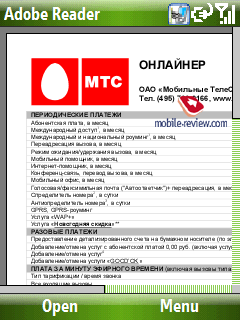
Java - emulator for applications written on Java. Its capabilities are very limited; in light of this fact 3D Java is not supported. In most cases support for Java-powered applications is not relevant on smartphones and communicators, today there are a tons of programs for Windows Mobile. Some users make an exception for OperaMini as this app is simply the winner in save-my-traffic contest. Another example - for Java-games addicts that need such emulator badly. However the regular emulator does not support additional libraries used for creation of Java applications for Nokia-, Motorola-branded and some other handsets. Hence nobody guarantees that these applications will launch and operate properly.
 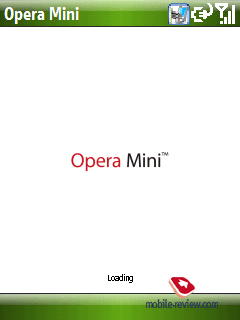
 
 

MP3 Trimmer. A small application that has much potential inside. It serves for cutting MP3 track, and thus makes them suited for use as ring tones. You just load an MP3 file, then state the start and end times in relation to the track length and then the app cuts the selected part out of the tune. After this you may set a new track as a ring tone or save it in the folder with other tunes. It is really hard to underestimate this application. Potentially, with MP3 Trimmer the number of people using paid services to add some more ring tones to their collection will decrease, particularly if the app will start coming included not only with HTC’s smartphones.
Quick notes – an app for making memos only. Its settings couldn’t be simpler: you may choose memory type for storing data and font size. Already created notes can be sorted by name and date.
Voice recorder presents you with no extra capabilities. Clip duration is limited to one minute.
Audio Manager – application similar to the standard Media Player. In terms of the abilities this app doesn’t differ from the built in player, saving for the interface.
The number of additional programs is similar to that found on the previous HTC-branded offerings. Here we should mention a very important detail – supplies for Russia might come equipped with another, more interesting set of pre-installed software. This will depend not only on the HTC but on the distributors and their wish for bringing new software as well.
Conclusion
The volume provided by the earpiece is average – while in underground or on a noisy street it is really difficult to hear the person on the other end, but we will reserve our final judgment until we get a hands-on with the commercial version of the S710. The loudspeaker is no match for HTC Trinity power-wise, and proves to be average for a Windows Mobile-based device. The silent alert is pretty much standard and is in line with that of ordinary handsets. Putting the phone in jacket’s pocket, you might not feel the vibration.
The device is expected to arrive in the market in May, 2007, at the initial price of 600-650 USD. With time this price will go down to the level of 500-550 USD. The current price of the Vox’s closest rival in terms of form-factor, smartphone Nokia E70, makes up about 450-500 USD. At that Nokia’s solution is clearly positioned as a tool for businessmen, who frequently have to handle mail and documents. In case of HTC, the positioning is not so sharply defined. The S710’s design, the first impression it leaves, its dimensions – with all this, let us say that this smartphone will draw attention of the youth. Of course, the ability to use the device as a mobile work place, similarly to Nokia E70, is still there. Naturally, the given example doesn’t claim to be extremely precise or exhaustive, as, generally speaking, the devices are totally different.
In the end, HTC S710 can be considered as a successful solution. The company has managed to create a good-looking smartphone, enhance it with QWERTY-keyboard and offer this mix for a reasonable price (the device is likely to cost 500 USD once the price drops down a little). In future we may expect further development of this concept in the form of an update of this model, addition of new features (radio, GPS, UMTS) or shift to the new Windows Mobile 6 Professional platform (Pocket PC).
Specifications:
- Type: Windows Mobile-based smartphone
- Form-factor: side-slider with QWERTY-keyboard and numberpad, or monoblock with slide-out QWERTY-keyboard
- Position in the line-up: above S650 (Cavalier)
- Rivals: Samsung i600, Motorola Q; Nokia E70
- Materials used : soft-touch plastic
- Operating system: Windows Mobile 6 Standard
- GSM Quad-band 850/900/1800/1900 MHz, EDGE/GPRS class B, Multi-slot standard class 10
- CPU: Texas Instruments OMAP 201 MHz
- RAM: 64 Mb (49.58 Mb of user-available);
- ROM: 128 Mb (63.38 Mb of user-available memory for storing data and applications)
- Connectivity: microSD, Bluetooth 2.0, ExtUSB for charging/synchronization, Wi-Fi (IEEE802.11b/g)
- Display: TFT 2.41” (49x36.5 mm – active area) with a resolution of 320x240 pixels, capable of 65 K colors, no backlighting settings
- Camera: CMOS 2 Mpix, flash-less, video recording capabilities
- Battery: detachable 1050 mAh Li-Ion
- Dimensions: 101.5x50x18.6 mm
- Weight: 140 g.
Artem Lutfullin (artem.lutfullin@mobile-review.com)
Translated by Oleg Kononosov (oleg.kononosov@mobile-review.com)
Published — 22 February 2007
Have something to add?! Write us... eldar@mobile-review.com
|
News:
[ 31-07 16:21 ]Sir Jony Ive: Apple Isn't In It For The Money
[ 31-07 13:34 ]Video: Nokia Designer Interviews
[ 31-07 13:10 ]RIM To Layoff 3,000 More Employees
[ 30-07 20:59 ]Video: iPhone 5 Housing Shown Off
[ 30-07 19:12 ]Android Fortunes Decline In U.S.
[ 25-07 16:18 ]Why Apple Is Suing Samsung?
[ 25-07 15:53 ]A Few Choice Quotes About Apple ... By Samsung
[ 23-07 20:25 ]Russian iOS Hacker Calls It A Day
[ 23-07 17:40 ]Video: It's Still Not Out, But Galaxy Note 10.1 Gets An Ad
[ 19-07 19:10 ]Another Loss For Nokia: $1 Billion Down In Q2
[ 19-07 17:22 ]British Judge Orders Apple To Run Ads Saying Samsung Did Not Copy Them
[ 19-07 16:57 ]iPhone 5 To Feature Nano-SIM Cards
[ 18-07 14:20 ]What The iPad Could Have Looked Like ...
[ 18-07 13:25 ]App Store Hack Is Still Going Strong Despite Apple's Best Efforts
[ 13-07 12:34 ]Infographic: The (Hypothetical) Sale Of RIM
[ 13-07 11:10 ]Video: iPhone Hacker Makes In-App Purchases Free
[ 12-07 19:50 ]iPhone 5 Images Leak Again
[ 12-07 17:51 ]Android Takes 50%+ Of U.S. And Europe
[ 11-07 16:02 ]Apple Involved In 60% Of Patent Suits
[ 11-07 13:14 ]Video: Kindle Fire Gets A Jelly Bean
Subscribe
|








